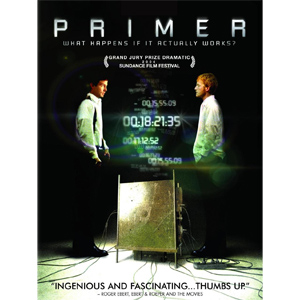I love films that make you think after you have watched them. Films that have you thinking about them for days after (I’m not talking about M. Night Shyamalan films which have an obvious twist at the end).
One of my favourite films over the last ten years is an independent film called Primer. The film focuses around two friends who are working on a device that will reduce the weight of items, however they accidentally create a machine that allows them to travel back in time. It is a fascinating film that demands a second watch…and a third. Anyone who says they understand the film after one viewing is a liar.
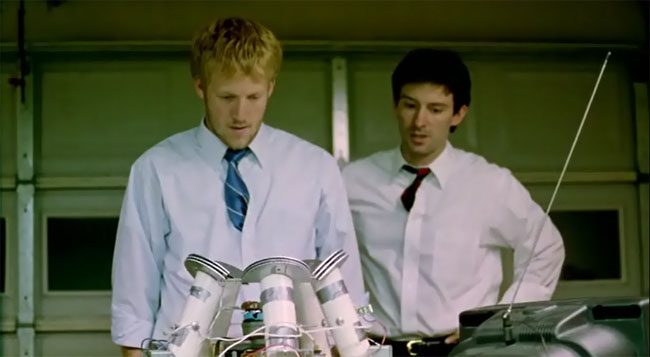
The film was written, directed, and produced, by Shane Carruth, one of the two main stars in the film. At the age of 30 he quit his job as an engineer to make Primer. I have nothing but respect for him for quitting his job and following his dreams. Amazingly, he completed the film on a budget of only $7,000 (nearly all of that money being spent on film stock). It is astounding to think that such a good film could be made on such a low budget (particularly with so many bad films out there costing over $100 million).
Shane Carruth’s second film is called Upstream Color is officially out today. When I read that his second film was being released, I decided to revisit Primer again (for what I believe is my fourth time).
Primer – What Happens If It Actually Works?
Primer is a film that makes sense once you have seen it at least twice and with every viewing you notice a few things that you had not noticed before. It is a relatively short film at only 77 minutes long, but it does not feel short when watching it. The film is not shown in the sequence that events occurred, which is one of the reasons why it is necessary to see the film another time.
After watching it once you will probably be confused about what actually happened. Watching it a second time is a completely different experience. It feels like watching a completely different film.
Where Primer excels over other time travel films is its realism (yes, realism in a fictional film about time travel). With 99% of time travel films, you are left contemplating the grandfather paradox. That is, someone from the future comes back to change the past, however if they come back to past to change something, their own future changes, making it impossible for them to come back to the past in the first place (and I’ve gone cross-eyed!). Even last years big time travel film Looper failed in this regard many times (i.e. the dismemberment of Seth raised many questions though I guess these issues can be countered by saying it creates a multiverse). As did Terminator in 1984 (the technology from the Terminator from the future was the basis for creating the Terminator that was created in the future).
In Primer, no rules are broken and you after watching the film you start to think that the whole thing is actually plausible (all I need is an old PC to make a whirring sound!).
If you have never seen Primer before, I encourage you to seek it out. You can buy the film on Shane Carruther’s official website ERBP Film. You can also rent it for around $2.99 or buy it for around $9.99 on:
Whilst I won’t be explaining Primer in full in this post, I will be talking a little about the plot, therefore if you want to see the movie, please stop reading now. I mean that. This is a film you do not want to spoil!
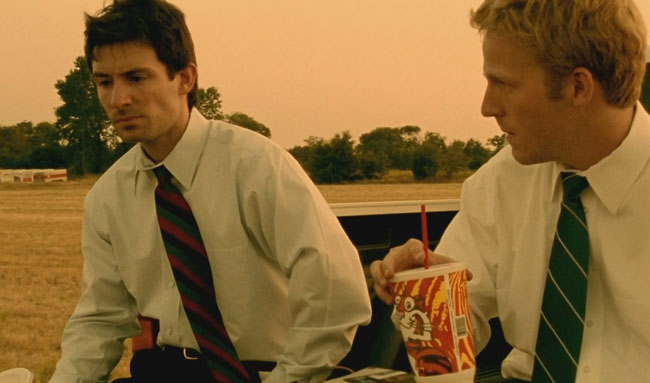
Primer Explained
SPOILERS – DO NOT READ THIS SECTION IF YOU HAVE NOT SEEN THE FILM
My original idea was to give my view on what happened on Primer. There is little point of me doing that. Firstly, because there are long detailed explanations that already exist online. Secondly, because my own understanding of the plot was helped by the explanations and comments of other fans of the film.
Therefore, rather than do a long explanation of how I understand the series of events in the film, I thought it would be better to simply link to resources that will help you understand it (articles, images and videos).
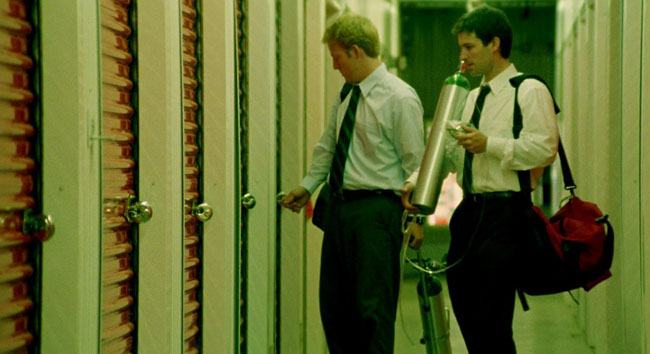
Primer Explained – Timeline Image Diagrams
Let’s start off with a visual explanation with how time travel works in Primer. It is vital that you understand the basic rules of time travel within the film as your whole understanding of the film itself depends on it. The image that is available on Wikipedia explains it perfectly. It will also help you understand why later in the story there is more than one version of Abe and Aaron going into the future.
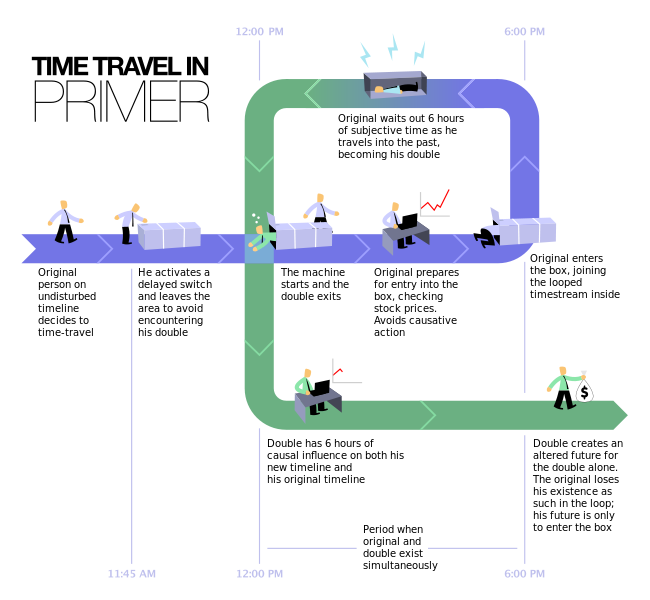
There are many timeline diagrams online that aim to explain Primer. A few are posted below (click on the image for the full size image). Unfortunately, most of these images are on dozens of websites online, therefore it was difficult for me to know where they originated. If you know where these images came from, please let me know in the comment area and I will link to the original creator :)
Diagram 1:
Diagram 2:
Diagram 4:
Diagram 5:
These images will not help you understand Primer….but they do highlight how the Primer timelines compares to other films :)
Primer Timeline:
Movie Timelines Diagram:
Primer Explained – Audio Commentary
The audio commentary below from qutm.org was only released a few months ago. It is one of the best ways of understanding the Primer timeline. All you do is start the audio commentary at the same time the film starts. The commentary will then walk you through each part of the film.
Primer Explained – Videos
There are not too many video explanations online. The main one available is a three part video series which breaks down everything with diagrams. Each video is around 9 to 10 minutes long.
Part 2 and Part 3 can also be found on YouTube.
Primer Explained – Articles
I found the explanation diagrams to be a little difficult to digest. The walkthrough articles that many fans of the film have published online are much easier to follow in my opinion. Below is a collection of some of the best explanations of the timeline in Primer. They should answer most of the questions you have about the film.
- Primer explained @ qntm.org
- Primer explained @ friendsinyourhead.com
- Primer explained @ Reddit
- The Primer Universe
- Primer: The Perils and Paradoxes of Restricted Time Travel
Narration - Primer Movie – Scene by Scene Explanation
- Primer and the Handwriting of Time Travelers
- A discussion about Primer on jaced.com
- IMDB Discussion Boards for Primer
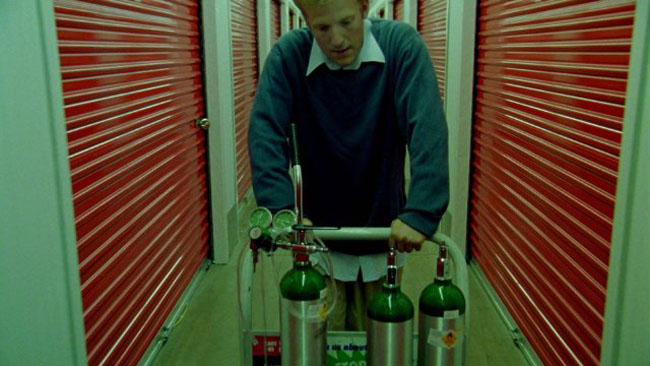
Shane Carruth Interviews
If you have read this far, you are obviously a huge fan of Primer. Therefore, I am sure you would love to hear more from the man himself, Shane Carruth. The interview below with Shane Carruth was published by The B-Movies Podcast last month. In the interview he talks about his new movie Upstream Color though he also talks a little about Primer.
More interviews with Shane Carruth:
- Shane Carruth—Primer—10/11/04
- Shane Carruth Answers All Our Questions About ‘Primer,’ ‘Upstream Color’ and ‘The Modern Ocean’
- An Interview With Shane Carruth
- A Primer Primer
- Making the Film – Interviews – Shane Carruth – 07/Mar/04
- Interview with Primer director Shane Carruth
- Buckle Your Brainpan: The Primer Director Is Back With a New Film
- IMDB Discussion Boards for Shane Carruth
The Future for Shane Carruth
It is great to see the return of Shane Carruth after a long absence. Upstream Color is just out and he is shooting another film called “The Modern Ocean” in a few months time. Sadly, the script he worked on for years has not came to fruition. The project, called “A Topiary”, took up a huge amount of his time but he was unable to secure the funds for it.
Apparently, he was learning how to design the 3D creatures himself for the film by visiting special effects companies.
I really hope that A Topiary gets made in the future, be it from investors or from funding through a website such as Kickstarter. It sounds epic. Here’s what he said about the film to Wired Magazine:
For a while, Carruth tried writing a romantic coming-of-age story set on the high seas. But soon he began mapping out something much bigger, an epic sci-fi story called A Topiary. It’s a tale told in two parts: The opening section follows a city worker who becomes obsessed with a recurring starburst pattern he sees hidden everywhere around him, even in traffic grids. He eventually joins with other believers, forming a kaffeeklatsch-cult that’s soon undone by greed and hubris.
The second half follows a group of 10 preteen boys who discover a strange machine that produces small funnels, which in turn can be used to build increasingly agile robotlike creatures. As their creations grow in power and size, the kids’ friendships begin to splinter and they’re forced to confront another group of creature-builders. The movie ends with a massive last-minute reveal, set deep in the cosmos, suggesting that everything we’ve just seen was directed by forces outside the characters’ control.
A Topiary consumed Carruth. He wrote much of it in the Dallas suburbs, living off the money from Primer. “There’s no way I could have done that if I had a wife or a family or health care,” he says now. “There’s a way to live that is incredibly thrifty.”
While working on the script, Carruth used a 3-D computer program to design all the creatures himself. And since the movie would require hundreds of effects shots, he began visiting f/x houses to learn about their workflow and to see how he might create his own effects. He even built his own small-scale CGI system, renting cloud computers and writing code. “That’s where I lose my time,” he says. “I get obsessed with these little things. I think there’s some novel way to find a solution, and I go down the pathway too far.”
After Carruth finished a first draft of the script, he gave it to director Steven Soderbergh, a fan who had reached out to Carruth after he saw Primer. Soderbergh asked his friend David Fincher to serve as co-executive producer. With their names and their blessing, Carruth made a mock-up trailer for investors, one that incorporated some of his own effects work plus images from many of the Spielberg movies he watched growing up. With a budget in the low $20 millions, Carruth began meeting with possible backers, a process that ended up consuming yet another year.
“Nobody ever said no,” Carruth says. “It was always enthusiasm and amazement and ‘We can’t wait for this!’ Meanwhile, no money’s sitting in the account.” He kept lowering the budget, getting it down to about $14 million, but even that couldn’t secure an investor. “If this were the ’70s, people would be throwing money at him,” Soderbergh says. “It’s just a different time now.”
Finally, Carruth realized that A Topiary was a problem he simply couldn’t solve. Worried he’d be forever stuck in a loop of endless meetings and fruitless go-aheads, he walked away. “I decided that if nobody was gonna say no, I was gonna have to say no,” he says. “It sort of just broke my heart.”
Shane Carruth’s experience suggests that even a successful film will guarantee you full control over your next project. Investors want involved in the project. I can understand this side of it. Can you imagine funding a film for $20 million and having the writer and director advise you that you have no say on what happens? You would fund another project. On the other side, I admire Carruth for not allowing other people tampering with his creation. Why should he give up final cut of his film or be told who he can or cannot cast. Even if he does not secure funds for A Topiary, I hope he continues to make films.
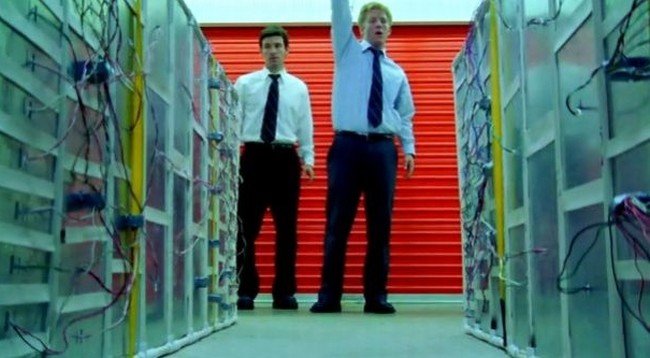
As much as I would love to see it, I do not believe there will ever be a sequel to Primer. There are no loose ends that need tied up. I cannot think of any plausible storyline that would happen after the events of the first film (can you?).
Summary
If you have read this far without watching Primer; shame on you! For everyone else, I hope you have found this article useful. Primer is one of the most intelligent films ever made. Most films that have a twist at the end of the film are easy to understand once you know what that twist is.
Primer is different. It really does take a few viewings to understand everything that happened. Once again, I will reiterate: Anyone who says that they understood everything about Primer after one viewing is a liar.
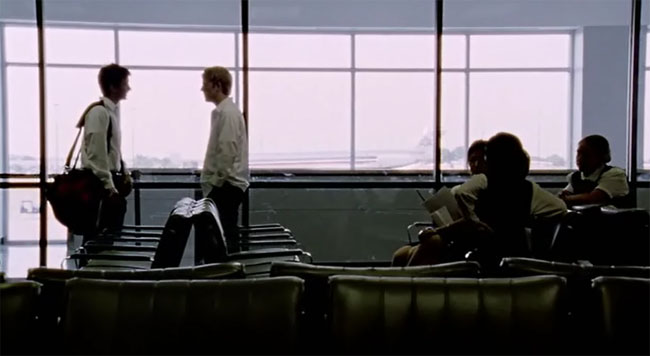
I’d love to hear from those of you who have seen Primer, so I encourage you to leave a comment and share with me your opinion of the film. Please leave a comment if there is any aspect of the film you do not understand and I will try and explain how I see those events.
Thanks for reading.
Kevin

